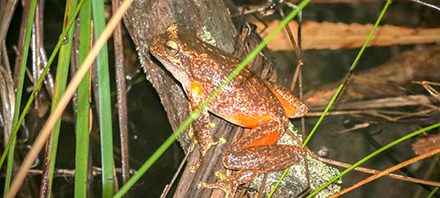
Forestry Corporation of NSW ecologists from Eden are excited after rediscovering a highly isolated population of the vulnerable Littlejohn’s Tree Frog (Litoria littlejohni) nearly two decades after its last local sighting. While in South Australia OneFortyOne is heading into the caves to search for microbats. Source: Timberbiz
Littlejohn’s Tree Frog was detected during a nocturnal Forestry Corporation survey, with approximately 20 individuals at a small pool of water.
Forestry Corporation’s Senior Field Ecologist, Dr Rohan Bilney said the rediscovery in Nadgee State Forest was a positive sign for the cryptic species, with only three previous detections of the species in the far south NSW.
“Littlejohn’s Tree Frog is a difficult to detect species, with the closest known population 100km away, across the Victorian border, and the closest known NSW population 250km away,” Dr Bilney said.
“There was speculation the species may have become locally extinct, following multiple unsuccessful surveys in recent years and because many frog species have declined in recent decades due to a disease called Chytrid fungus, which is causing declines globally.
“This rediscovery gives hope that other populations of rare frogs continue persisting in areas where they have declined and considered potentially locally extinct.”
The survey results mean Forestry Corporation has recorded the species’ location and can take steps to best protect it when planning operations in the area.
With over 500 State forests throughout NSW, Forestry Corporation actively manages forests to produce a sustainable supply of timber and maintain forest health and habitat.
While most people know that forests absorb carbon dioxide, helping to mitigate the impacts of climate change; they are one of the biggest contributors to regional economies, and they are also home to a bat cave or two.
Nestled in the Green Triangle forests are a series of caves that are home to the critically endangered Southern Bent-winged Bat. At a tiny 52-58mm these microbats have seen their populations in rapid decline since the 1950s.
In 2016 leading regional environmental organisation Nature Glenelg Trust and OneFortyOne joined forces to purchase land and trees next to the Mount Burr Swamp, with the aim of restoring the drained wetlands on site.
Lying between the neighbouring forests containing bat caves, both organisations were hopeful that once the wetlands were restored the bats would make use of them,” OneFortyOne’s Chief Forester, Glen Rivers said.
“We wanted to partner with Nature Glenelg Trust on this project as soon as we heard about it. Our organisations share the same values being strongly committed to ensuring our respective activities have a long-lasting positive impact on this region”.
It certainly didn’t take long for that positive impact to materialise, and two years into the wetland restoration project the wildlife has returned, including the critically endangered Bent-winged bat.
“We were fairly confident that the bats would make use of the swamp property as they are known to forage in wetlands, but it hadn’t been confirmed – until now,” Nature Glenelg Trust’s Rose Thompson said.
The team at Nature Glenelg Trust undertook a series of surveys and discovered Long-eared Bats, Forest Bats, as well as the critically endangered Southern Bent-winged Bat.
“This is just fantastic news”, said Mr Rivers. “It just goes to show you that something as simple as raising the water level in a wetland, can help save a critically endangered species.”





